Shrewsbury School
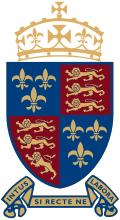 | |
| Motto |
Latin: Intus Si Recte Ne Labora (If Right Within, Trouble Not) |
|---|---|
| Established | 1552[1] |
| Type |
Public school Independent day and boarding school |
| Headmaster | Mark Turner[1] |
| Chairman of Governing Body | Matthew Collins |
| Founder | King Edward VI |
| Location |
Kingsland Shrewsbury Shropshire SY3 7BA England 52°42′14″N 2°45′44″W / 52.7038°N 2.7622°WCoordinates: 52°42′14″N 2°45′44″W / 52.7038°N 2.7622°W |
| DfE URN | 123608 Tables |
| Staff | ca. 100 (full-time teachers) |
| Students | ca. 770 students |
| Gender | Coeducational |
| Ages | 13–18 |
| Colours | Royal blue & white |
| Publication | The Salopian |
| Former pupils | Old Salopians |
| School Song | Floreat Salopia |
| Website |
www |
Shrewsbury School is an English co-educational independent school for pupils aged 13 to 18 in Shrewsbury, Shropshire, founded by Royal Charter in 1552.[1] The present campus, to which the school moved in 1882, is on the banks of the River Severn.[1]
Shrewsbury school is one of the original seven public schools as defined by the Public Schools Act 1868. It was originally a boarding school for boys; girls have been admitted into the Sixth Form since 2008 and there are approximately 130 day pupils.[2] Since 2014 Shrewsbury School has been fully co-educational. Pupils are admitted at the age of 13 by selective examination.[2] For approximately ten per cent of the pupils, English is a second or additional language.[1]
The school's old boys – or "Old Salopians" – include naturalist Charles Darwin; poet Sir Philip Sidney; Sidney's biographer, Fulke Greville, whose virtues extolled the chivalrous code of his era; Astronomer Royal Martin Rees; authors Samuel Butler and Nevil Shute; broadcaster John Peel; and comedian and writer Michael Palin.
History
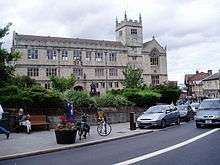
Following a petition in 1542 to Henry VIII from the townspeople of Shrewsbury for a free grammar school, Shrewsbury School was founded by charter in 1552 under King Edward VI by Adam Jones in three rented wooden buildings, which included Riggs Hall, built in 1450, and now the only remaining part of the original foundation. Originally, the curriculum was based on Continental Calvinism, under its first headmaster, Thomas Ashton (appointed 1561) and boys were taught the catechism of Calvin. The school attracted large numbers of pupils from Protestant families in Shrewsbury, Shropshire and North Wales, with 266 boys on its roll at the end of 1562.[3] It had few facilities so early pupils lodged with local families. Philip Sidney, who attended Shrewsbury between the ages of nine and thirteen, lodged with the family of George Leigh, Member of Parliament for Shrewsbury. Having achieved a reputation for excellence under Ashton, in 1571 the school was augmented by Queen Elizabeth I. Although Ashton had resigned from his headmastership in 1568, he returned to Shrewsbury in 1578 to help draw up the ordinances governing the school, which were in force until 1798; under them, the borough bailiffs (mayors after 1638) had power to appoint masters, with Ashton's old St John's College, Cambridge having an academic veto.[4]
The stone buildings on Castle Gates, including a chapel, dormitories, library and classrooms were completed by 1630 and the school continued in these, until it was relocated in 1882. Subsequently, the premises were converted to a public Free Library and Museum by the Shrewsbury Borough Council, opening in their new role in 1885.[5] In the 20th century the library purpose gradually took over the building. After a period of structural deterioration, followed by extensive restoration work, the buildings were re-opened entirely as Shrewsbury Public Library in 1983.[6][7]
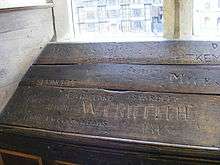
The reputation of the school declined in the following centuries. Samuel Butler became headmaster in 1798.[8] The school had just three headmasters during the 19th century. Butler was succeeded by his pupil Benjamin Hall Kennedy (of Latin Primer fame) in 1836,[8] who in turn gave way to Henry Whitehead Moss in 1866. Under Butler and Kennedy, Shrewsbury was one of three provincial schools among the nine studied by the Clarendon Commission of 1861–64.[9]
In 1882, Moss moved the school from its original town centre location to a new site of 150 acres (61 ha) in Kingsland, on the south bank of the River Severn overlooking the town. A legacy of this move can be seen in the school campus being referred to as "The Site". The school was set up in a building that had at different times housed a foundling hospital and the Shrewsbury workhouse; buildings have since grown up around the edge of the campus with sports pitches in the centre.
Moss was succeeded in 1908 by the Cyril Alington, then Master in College at Eton. Alington, though a Fellow of All Souls College, Oxford, was a sportsman, evidenced by the 1914 appointment as his secretary of Neville Cardus, the future cricket journalist who had joined the school in 1912 as the school's assistant cricket professional. At the time of his appointment as Headmaster, Alington was younger than any of the masters on the staff, so to bring in new blood into the teaching staff, he recruited several former Collegers from Eton, most notably The Rev. Ronald Knox [See 'Ronald Knox' by Evelyn Waugh 1959 & 'The History of Shrewsbury School' by J.B.Oldham, 1952]. Alington revived attendance which had fallen away under Moss, and he was an energetic builder; the school hall is named after him.
Since the turn of the millennium, the school's site has seen investment. A new music school, The Maidment Building, was opened by Prince Charles in 2001.[10] The Main School Building saw an internal renovation over several years, modernising all classrooms. A new boarding house has been completed, as has a new world-class indoor cricket centre and a new swimming pool. In 2003 Shrewsbury International School, Bangkok was opened in Bangkok, Thailand, on the banks of the Chao Phraya River.
In 2005 Shrewsbury School was one of fifty of the country's leading independent schools which were found guilty of running an illegal price-fixing cartel which had allowed them to drive up fees for thousands of parents.[11] Each school was required to pay a nominal penalty of £10,000 and all agreed to make ex-gratia payments totalling three million pounds into a trust designed to benefit pupils who attended the schools during the period in respect of which fee information was shared.[12] Jean Scott, the head of the Independent Schools Council, said that independent schools had always been exempt from anti-cartel rules applied to business, were following a long-established procedure in sharing the information with each other, and that they were unaware of the change to the law (on which they had not been consulted).[13]
Sport
The main sport in the Michaelmas (autumn) term is football, in the Lent term fives and rugby, and in summer cricket. Rowing is another main sport which happens all year. The admission of girls in 2014 has seen the introduction of field hockey, netball and lacrosse, with cricket and tennis played during the summer term.
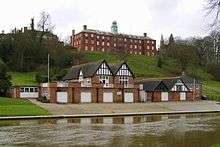
The Royal Shrewsbury School Hunt (RSSH or "the Hunt") is the oldest cross-country club in the world, with written records (the Hound Books) going back to 1831 and evidence that it was established by 1819.[14] The sport of "the Hunt" or "the Hounds", now known as a Paper Chase, was formalised at the school around 1800. Two runners (the "foxes") made a trail with paper shreds and after a set time they would be pursued by the other runners (the "hounds"). The club officers are the Huntsman, Senior and Junior Whips and the hounds start most races paired into "couples" as in real fox hunting; the winner of a race is said to "kill".[15] In his 1903 semi-autobiographical novel The Way of All Flesh, Old Salopian Samuel Butler describes a school based on Shrewsbury where the main protagonist's favourite recreation is running with "the Hounds" so "a run of six or seven miles across country was no more than he was used to".[16] The first definite record of the Annual Steeplechase is in 1834, making it the oldest cross country race of the modern era.[14] The main inter-house cross-country races are still called the Junior and Senior Paperchase, although no paper is dropped and urban development means the historical course can no longer be followed. Every October the whole school participates in a 3.5 mile run called "The Tucks", originally intended to prevent pupils attending a local horse race.[17] The school also lays claim to the oldest track and field meeting still in existence, which originated in the Second Spring Meeting first documented in 1840. This featured a series of mock horse races including the Derby Stakes, the Hurdle Race, the Trial Stakes and a programme of throwing and jumping events, with runners being entered by "owners" and named as though they were horses.[14]

The school's original Castle Gates premises had little in way of provision for games. Under Dr Butler, there were two bat fives courts and playgrounds before and behind the buildings, but after the arrival of Dr Kennedy football was permitted, for which the school acquired a ground in Coton Hill (north of Castle Gates).[7]
The present school buildings in Kingsland are arranged around the sports fields which have nine grass football pitches and one of Astroturf; almost all boys play football in the Michaelmas term.[18] Salopians were prominent in the early history of the organised game at Cambridge University, according to Adrian Harvey "Salopians formed a club of their own in the late 1830s/early 1840s but that was presumably absorbed by the Cambridge University Football Club that they were so influential in creating in 1846".[19] This would make the club the oldest football club in the world. The school has an 1856 copy of the Cambridge rules of football, the oldest extant copy of the Laws of the Game[18] predating the 1863 rules of the FA.
Houses
There are eight boys' boarding houses, three girls' boarding houses (with a fourth opening in September 2017) and two for dayboys, each with its own housemaster or housemistress, tutor team and matron. Each house also has its own colours. In football each house competes in four different leagues (two senior, two junior) and three knock-out competitions (two senior, one junior). A single house will hold around 60 pupils, although School House and each of the dayboy houses hold slightly more. Having about 90 pupils School House used to be divided into Doctors (black and white) and Headroom (magenta and white) for most sporting purposes whilst being one house in other respects but this distinction was abolished in around 2000. The houses and their colours are:
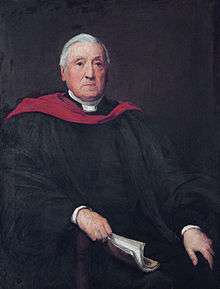
- Churchill's Hall Dark Blue & Light Blue (Richard Hudson) (opened in 1882, listed building)
- The Grove Cornflower Blue and White (Clare Wilson) (converted to girls' house in the summer 2014)
- Ingram's Hall Green & White (Mike Wright)
- Moser's Hall Deep Red & Black (Paul Pattenden) (opened in 1884, listed building, girls house from September 2017)
- Oldham's Hall Chocolate Brown & White (Marcus Johnson) (opened in 1911, listed building)
- Port Hill (formerly merged with Radbrook as 'Dayboys Hall') Gold & Red (Andy Barnard)
- Radbrook (formerly merged with Port Hill as 'Dayboys Hall') Violet & White (Richard Case)
- Ridgemount Royal Blue & Old Gold (Will Hughes) (opened in 1926, listed building)
- Rigg's Hall Chocolate & Gold (Matthew Barrett) (opened in 1882, listed building)
- School House Black, Magenta & White (Hugo Besterman)
- Severn Hill (formerly known as 'Chances') Maroon & French Grey (Dan Nicholas)
- Mary Sidney Hall Dark Blue & Pink (Naomi Pritchard) (opened in September 2008)
- Emma Darwin Hall Wedgwood Blue & Green (Kait Weston) (opened in September 2011)
School Arms
The Arms of the school are those of King Edward VI being The Arms of England (three lions passant) quartered with those of France (fleur-de-lys).[20]
Headmasters
- 2010– : Mark Turner (will leave in 2018)
- 2001–10: Jeremy W. R. Goulding
- 1988–2001: Ted Maidment
- 1981–88: Simon J. B. Langdale
- 1975–80: Sir Eric Anderson
- 1963–75: A. R. D. Wright
- 1950–63: John "Jock" Magnus Peterson
- 1944–50: John Wolfenden
- 1932–44: Henry Harrison Hardy (father of the actor Robert Hardy)
- 1917–32: Harold A. P. Sawyer
- 1908–17: Cyril Argentine Alington
- 1866–1908: Henry Whitehead Moss
- 1836–65: Benjamin Hall Kennedy
- 1798–1836: Dr Samuel Butler (afterwards Bishop of Lichfield)
- 1771–98: Revd. J. Atcherley
- 1754–70: Charles Newling
- 1735–54: Leonard Hotchkiss
- 1727–35: Robert Phillips
- 1723–27: Revd. H. Owen
- 1687–1723: Revd. R. Lloyd
- ?1646–87: Revd. A. Taylor
- 1645-62: Thomas Pigott (deprived under Act of Uniformity)
- 1637–45: Revd. Thomas Chaloner (expelled by Parliamentarians, died 1664)
- 1583–1635: John Meighen
- 1571–83: T. Lawrence
- 1561–71: Thomas Ashton
Notable masters
- Nick Bevan (housemaster, rowing coach, later headmaster of Shiplake College)
- Anthony Chenevix-Trench (housemaster of School House, later headmaster of Bradfield College, Eton College and Fettes College)
- Frank McEachran[21]
Old Salopians
Former pupils are referred to as Old Salopians (from the old name for Shropshire). Contemporary (i.e. living) Old Salopians include:
- Alastair Humphreys, adventurer
- Christopher Hope (born 1972), journalist, political editor of The Daily Telegraph
- Christopher Booker (born 1937), journalist, founder of Private Eye
- Christopher MacLehose (born 1940), publisher
- Sir Christopher Wallace (born 1943), Lieutenant General and Royal Green Jackets
- Sir Colin Hugh Verel McColl (born 1932), Former Head of the Secret Intelligence Service (MI6)
- David Lovell Burbidge (born 1943), High sheriff of the West Midlands County 1990–91
- James Taylor (born 1990), Nottinghamshire and England cricketer.
- Sir John Stuttard (born 1945), Alderman and Lord Mayor of the City of London 2006–07
- Jonathan Legard (born 1961), journalist and broadcaster
- Jonty Heaversedge (born ~1971), TV doctor
- Lord Hutton (born 1931), Law Lord, Lord Chief Justice of Northern Ireland, Chairman of Hutton Inquiry
- Martin Rees, Baron Rees of Ludlow (born 1942), Astronomer Royal, erstwhile Master of Trinity College, Cambridge, Past President of Royal Society
- The Right Honourable The Lord Heseltine CH PC (born 1933), politician
- Michael Palin CBE (born 1943), actor and TV presenter
- Nicholas Rankin (born 1950), writer and broadcaster
- Nick Hancock (born 1962), actor and TV presenter
- Nick Owen (born 1947), TV presenter
- Piers Brendon, writer
- Richard Ingrams (born 1937), journalist, founder of Private Eye
- Simon Shackleton (born 1968), DJ, musician
- Sir Mark Moody-Stuart (born 1940), ex-chairman of Royal Dutch Shell and Chairman of the UN Global Compact committee
- Stephen Glover, journalist & columnist
- Tim Booth (born 1960) musician
- Twm Morys (born 1961) Welsh poet and musician.
Victoria Cross holders
Two Old Salopians received the Victoria Cross, both in the First World War, 1914–18.
References
- 1 2 3 4 5 Ofsted Social Care report 2008. Retrieved 19 March 2010
- 1 2 Independent Schools Inspectorate report 2007 Retrieved 19 March 2010
- ↑ Oxford Dictionary of National Biography, Volume 2. Oxford University Press. 2004. p. 684. ISBN 0-19-861352-0.Article on Thomas Ashton by Martin R. Speight.
- ↑ Oxford Dictionary of National Biography, Volume 2. pp. 684–685.
- ↑ Beryl Copsey (April 1985). Read All About It! Grand Opening of Shrewsbury's free library 100 years ago. The Shropshire Magazine. p. 18-19.
- ↑ A plaque erected by The Rotary Club of Shrewsbury, commemorating the club's 60th anniversary in 1985, reads: Castle Gates Library erected by Edward VI in 1552, Shrewsbury School occupied this site until 1882. The stone buildings were built 1594-1630. Judge Jefferys and Charles Darwin were educated here. Re-opened as a library in 1983 after complete renovation.
- 1 2 Shrewsbury Library, Its History and Restoration. Shropshire Libraries. 1983. ISBN 0-903802-26-0.(Unpaginated)
- 1 2
 Lee, Sidney (1886). "Butler, Samuel (1774-1839)". In Stephen, Leslie. Dictionary of National Biography. 8. London: Smith, Elder & Co.
Lee, Sidney (1886). "Butler, Samuel (1774-1839)". In Stephen, Leslie. Dictionary of National Biography. 8. London: Smith, Elder & Co. - ↑ Stray, Christopher (2005) Histories of the Nine Clarendon Schools: v. 1 Thoemmes Continuum ISBN 1-84371-108-7, ISBN 978-1-84371-108-7.
- ↑ "Shrewsbury School". TES. Retrieved 21 April 2011.
- ↑ TimesOnline
- ↑ www.oft.gov.uk
- ↑ "Private schools send papers to fee-fixing inquiry". The Daily Telegraph. London. 1 March 2004. Retrieved 15 March 2011.
- 1 2 3 Robinson, Roger (December 1998). "On the Scent of History". Running Times: 28.
- ↑ "History of The Tucks". Shrewsbury School. 2011.
- ↑ Butler, Samuel (1903). "39". The Way of All Flesh. Project Gutenberg.
- ↑ "The Tucks". Shrewsbury School. 2011.
- 1 2 "Football". Shrewsbury School. 2011.
- ↑ Harvey, Adrian (2005). Football: The first hundred years. Routledge. p. 251.
- ↑ "Shrewsbury School coat of arms", The Victorian Web.
- ↑ 'Frank McEachran', obituary in Books and Bookmen, vol. 20 (Hanson Books, 1975), pp. 58–59.
- Alan Stewart, "Philip Sidney: A Double Life", Chatto and Windus, 2000. ISBN 0-7011-6859-5
- "Shrewsbury Library: Its History and Restoration" - A.M Carr Shropshire Libraries 1983
Further reading
- Annals of Shrewsbury School, George William Fisher & John Spencer Hill (1899)
- History of Shrewsbury School, 1551–1888, John Brickdale Blakeway & Alfred Rimmer (1889)